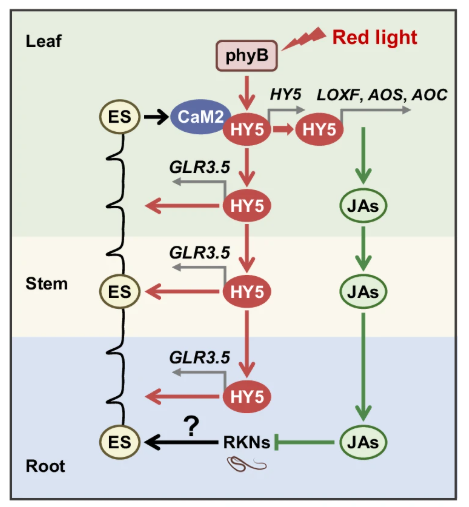Light and Electricity in Plant Defense
Plants cannot move, but instead they rely on sophisticated signaling networks to fight off attackers. Previous studies have examined either “light responses” or “electrical signals” individually. However, how these two systems are integrated into a whole-plant defense strategy has long remained a mystery.
The recent study sheds light on this issue, identifying HY5 as the key molecule. HY5 is originally known as a transcription factor in light signaling. Yet, when plants are attacked by pathogens, HY5 functions as a hub that unifies defense responses between leaves and roots, playing a crucial role in plant immunity.
Experimental Design and Analytical Approach
The research team conducted experiments using tomato plants infected with root-knot nematodes.
- Electrical signal recording: Nematodes were inoculated on roots, and stem surface potentials were measured with electrodes.
- Mutant lines: HY5-deficient and GLR3.5-deficient lines were used for comparative analysis. GLR3.5: a key gene encoding a calcium channel that initiates electrical signaling.
- Protein mobility: HY5 was tagged to visualize its movement from leaves to roots.
- Molecular interaction analysis: The binding of calmodulin (CaM2, a calcium sensor) to HY5 was confirmed through mutant assays and promoter activity tests. Calmodulin: mediates intracellular Ca²⁺ signaling triggered by electrical stimuli.
This multi-level approach allowed the team to track both electrical signals and transcription factor activity simultaneously, a methodological advance compared to previous studies that had treated these pathways separately.
Results and Discussion: HY5 as a Dual-Role Hub Protein
The findings were striking:
- Electrical signals from roots activate HY5 in leaves. Root infection by nematodes triggered calcium-dependent electrical waves, which were transmitted to leaves via GLR3.5, leading to HY5 activation.
- HY5 triggered a jasmonate burst. In leaves, HY5 induced the expression of JA biosynthesis genes, rapidly launching a defense response.
- CaM2 boosted HY5 activity. Calcium release in leaves activated CaM2, which bound to HY5 and further enhanced its transcriptional activity.
- HY5 moved to roots and induced GLR3.5 expression. HY5 itself translocated from leaves to roots, where it promoted GLR3.5 expression. This strengthened the transmission of electrical signals and reinforced the defense loop.
Taken together, HY5 is not just a simple transcription factor with a single function. It acts as:
- A commander in leaves, switching on the biosynthetic pathway of defense hormones.
- An engineer in roots, reinforcing the “electrical circuits” that transmit alarm signals.
Thus, HY5 serves as a dual-role hub in plant immunity, enabling efficient and sustainable systemic defense.

Conclusion: HY5 as an Integrative Defense Hub
This study demonstrates that plants integrate two distinct types of signals—light and electrical—through a single molecule, HY5. This mechanism allows a local infection cue to be instantly converted into a systemic defense response across the entire plant.
The authors position HY5 as “a systemic signaling hub connecting light and electrical signals.” For broader interpretation, HY5 can be seen as both a defense commander and a signal engineer—a protein that performs two critical roles at once.
Future applications may involve manipulating light conditions or HY5-related factors to improve crop resistance against pests and environmental stresses.



コメント